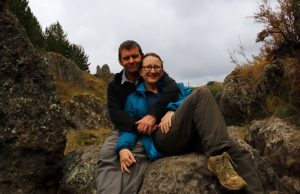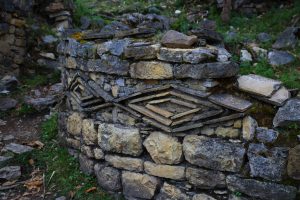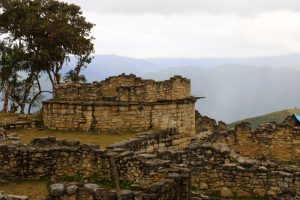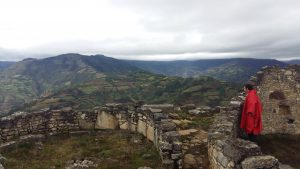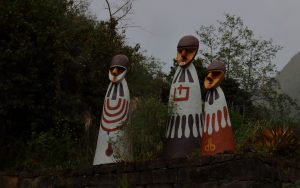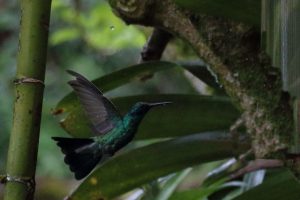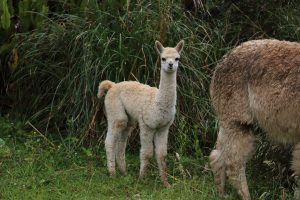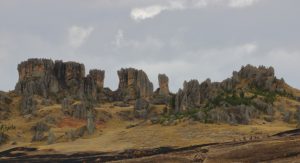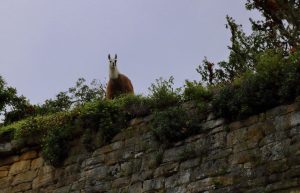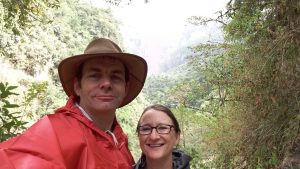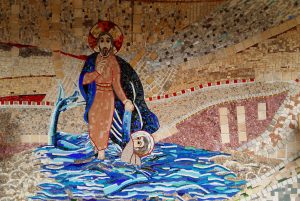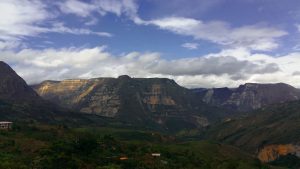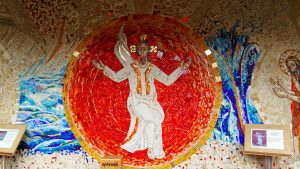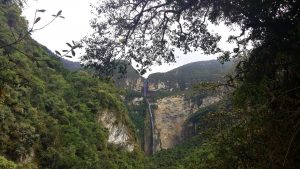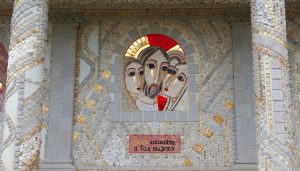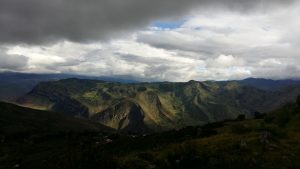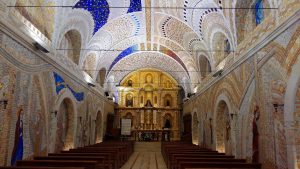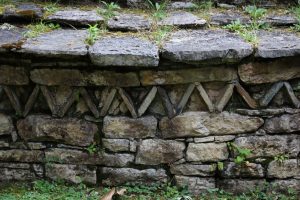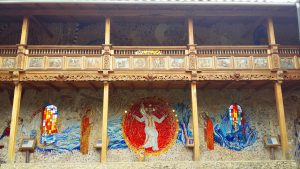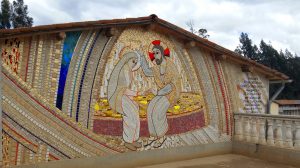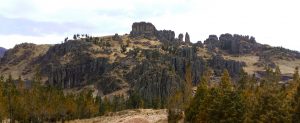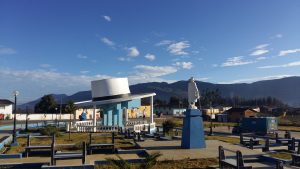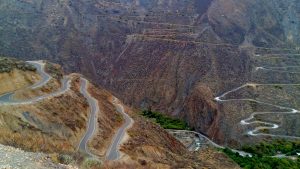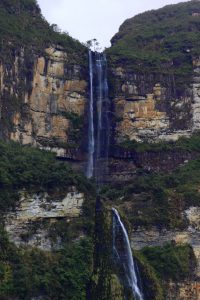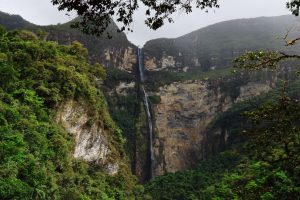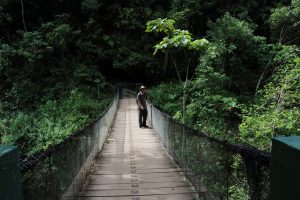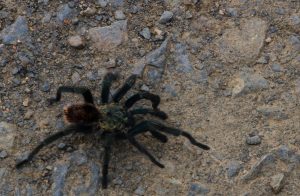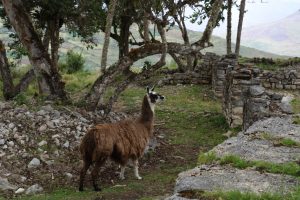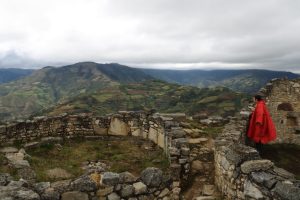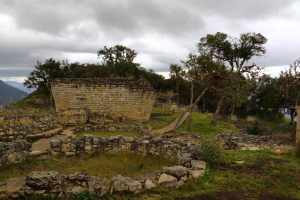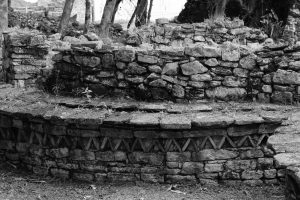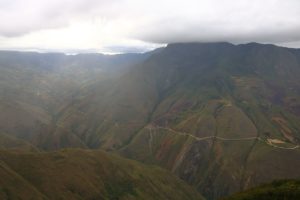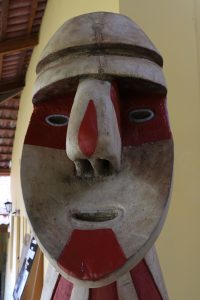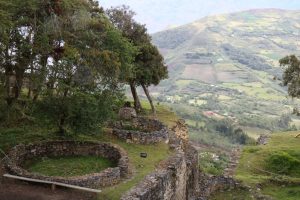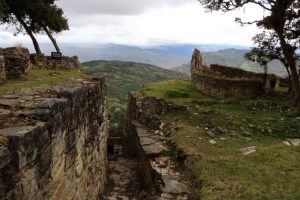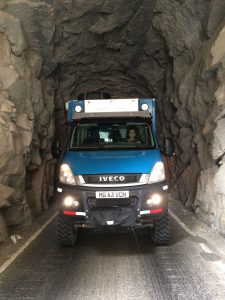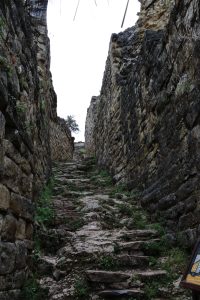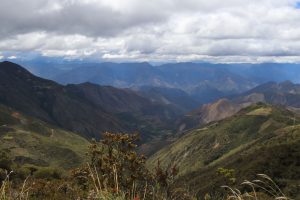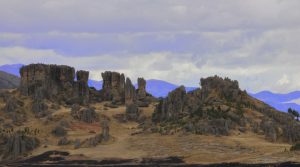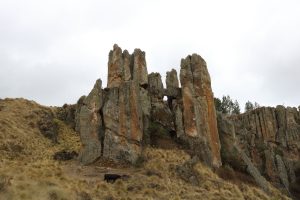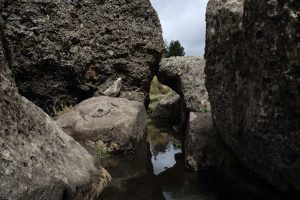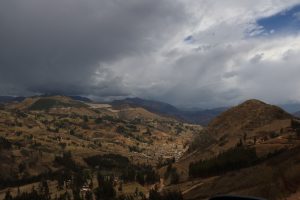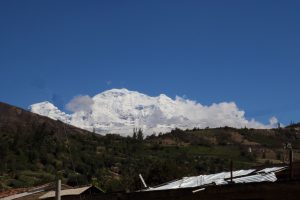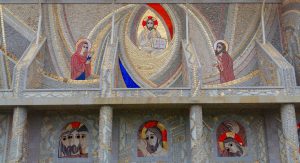“Heading to the Dakar Rally?” we asked the friendly Brit biker at the Peruvian border, “Yeah… I’m competing” came the reply. Blimey. Impressed.com. We’re not quite, or even anywhere near, as brave as Lyndon, but we are keen to go and see what antics the competitors get up to on their way around the route. Our new claim to fame: we now know one of the Dakar riders who we can go to cheer on!
Peru by the back door
We’re now in Peru for the second time. This time we’re far inland from the coastal route that we took north-bound. Now we’re taking a small rough back-road through the mountains to a relatively little used border post at La Balsa. On this whole trip we have met very few Brits travelling around South America, so we are surprised and pleased to meet Brit bikers Lyndon and Anthony at such a remote crossing. Lyndon is on a round-the-world bike trip and has been competing in various events as he goes. Naturally in South America he wants to do the biggie of them all… The Dakar. After a sociable chat with them we head on our way leaving the chaps to do their border formalities stuff.
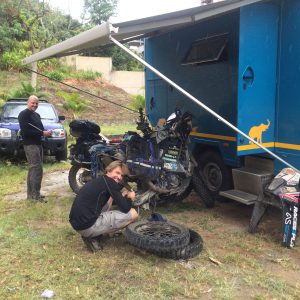 In the next small town we park up outside a hotel and as we settle down in Cuthbert with a glass of plonk for the evening, we hear the unmistakable roar of two overlanding motorbike engines pull-up alongside us. Ha! Brilliant! The guys have caught up with us and we have a great evening with them and a few beers to hear all about the Dakar plans.
In the next small town we park up outside a hotel and as we settle down in Cuthbert with a glass of plonk for the evening, we hear the unmistakable roar of two overlanding motorbike engines pull-up alongside us. Ha! Brilliant! The guys have caught up with us and we have a great evening with them and a few beers to hear all about the Dakar plans.
Next morning Lyndon and Anthony need to do a bit of admin on their bikes, but the rain starts. Cuthbert to the rescue… out comes the awning to make a perfect motorbike servicing shelter and our recently acquired Yorkshire Tea bags also come in handy to keep the workers happy. The friendly manager of the hotel comes out to see what’s going on and takes a few photos of us all. It’s only later in the day when we see his posts on FB that we realise the manager might have got slightly the wrong end of the stick… he seems to think that we are part of Lyndon Poskitt’s Dakar racing team! That would obviously be rather cool for Cuthbert… except Lyndon is competing in the ‘unsupported’ category, so he’ll be a one-man-band.

Marcus thirsty at Gocta Falls
Anyway… work sorted, we say our farewells to Anthony and Lyndon and push on along the tiny mountain roads of northern Peru. There are stunning views and there’s lots to see and do, but some parts are veeery slow going. We take a side track to see Gocta Falls. Amusingly, locals tell us proudly that this is the third highest falls in the world, but a later check with Mr Google more reliably informs us that it is in fact the 16th highest! Nevertheless, they’re rather lovely and worth the 4 hour round hike.
Kuelap
Another of the many ‘must-do’ sights if you happen, as not many people do, to be traversing the northern highlands of Peru, is the ruins of Kuelap. Some archaeology-type-chaps claim that this site is as significant as Machu Picchu. It is indeed very interesting and sits on a magnificent high mountain-top, although due to the prevailing murk and drizzle we really didn’t see it all at its best.
In anticipation of attracting more tourists, the government is spending a fortune installing a huge cable-car contraption to take visitors up the mountain. This is a fairly remote area with very limited tourism infrastructure, so this could be a slightly over-optimistic investment, but we’ll wait and see… It will at least save a drive of one hour each way from the nearest small town on a precarious stretch of early 20th century civil engineering that currently passes, rather disingenuously, as a ‘road’. Interesting though Kuelap is, it lacks the visual wow-factor of Machu Picchu so for the foreseeable future at least, MP can rest assured of its continued status as Peru’s top-dog tourist tick.
There’s lots of stuff to see in the northern highlands of Peru, but it would be ditch-water dull to bore you with detail of it all. Among our highlights were:
- glossy emerald green humming-birds in the rain-forest (incidentally… have you ever tried to get a decent snap of one of those little critters? They don’t stay still for the paparazzi, even for a second… they’re impossible!!!);
- a fascinating community-run museum of Leymebamba with scores of mummies found in the surrounding hillsides;
- valleys of curious rock-carved water-courses of Cumbe Mayo which anthropologists are still today unable to explain; and
- a stunning gem of a church, covered in the most impressive glass mosaics, sitting at the back-end of the non-descript tiny village of Pollac. We’re really not churchy-types, but the beauty and craftsmanship of these modern mosaic designs really should be better known to the world.
Slow-going gets even slower
We mentioned it’s slow on them-there tracks of north Peru. Is it slow because it’s rough? No, not really. Or very steep? No. It’s slow because the road has been precariously cut as a ledge into a mountainside. And although it is (in theory) a two-way road, they didn’t waste much effort in cutting out space for vehicles to pass. In places, it is extremely narrow with sheer drops of hundreds of metres off the side. And for that added measure of excitement, there is a sprinkling of blind bends so you can’t even see if you’re going to meet another vehicle head-on around the corner. That’s why it’s slow going! On the descent sections, Marcus spends much of the time extolling the virtues of Cuthbert’s ‘amazing’ retarder braking system that he installed before we came to the Andes and he explains frequently how much more difficult it would be to handle these roads in Cuthbert without it. Meanwhile, I spend much of the time looking down the sheer drops feeling relieved that it is not me manoeuvring Cuthbert around the bends… but I should not have ‘counted my chickens’! The slow-going is about to get even slower.
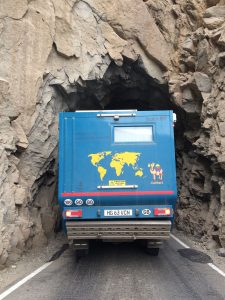
Cosy fit
After a quiet night-stop by a river in the bottom of a remote and very steep-sided valley, we set-off early to try to make up some ground. Immediately we notice a curious rattle from under the cab and Marcus’ investigations soon reveal that the UJ bearing of the prop-shaft to the front axle has seized. Hmmm. Rather than sound like I understand what that means, I’ll just explain that in order to fix it at the side of the road, Marcus has to replace the front axle prop-shaft with the prop-shaft from the aforesaid ‘amazing’ retarder system and rely on the ordinary brakes for a few days until we can find a replacement UJ bearing. Just as he is finishing the fix, he manages to somehow deliver a massive hammer-blow to his left index finger. I’ll cut short the descriptive account of his colourful language and rolling around on the floor in pain, and skip to assure those concerned that no serious damage is done. The only serious consequence is that he is in too much pain to drive and I have to sit in the seat.
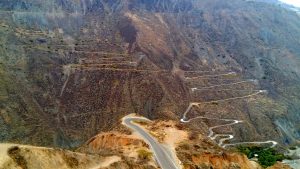
It started off surfaced, then got rough!
Now… I don’t drive Cuthbert very often. I do the occasional stint to ‘keep my hand in’, but today we have ahead of us one of the toughest day’s driving that we have done so far in South America. Off we set… along those tight mountain roads… with no ‘amazing’ retarder. Initially it is up-wards to climb out of the 1,500 metre valley to Pallasca. This is scary enough, but then comes the inevitable long descent down into the Tablachaca river valley. On the rare occasion that I dare to look up from the road ahead, I notice some stunning views and lots of condors circling around us, but I don’t really have the capacity to take it all in! Cuthbert’s brakes overheat very quickly if they’re used on long descents, so with no retarder system I’m driving the whole day using mostly gears and engine-braking to keep us from crashing over the precipice. It starts off surfaced then deteriorates into a rough track. Progress is extremely slow; for 8 hours we average no more than around 25 kph.
Eventually we join the ‘main’ PE3-N which improves our speed for a while, but we’re soon back on extremely tight tracks in the long narrow gorge of Cañon del Pato. Here, the road passes through many, many tiny tunnels hacked through the rock. The interior walls are jagged with large sharp protrusions that threaten some serious damage to Cuthbert’s cabin if I don’t judge the road positioning accurately. The tunnels have no lighting and are single-track width whilst taking two-way traffic. In most of the tunnels you can’t see the end-daylight when you enter; you just have to hoot and hope that nobody is coming towards you with no lights on.
OK… I think you get the gist… I’m a hero!! 🙂 And boy am I shattered at the end of the day! I never thought overlanding could be so tiring! Next day, Marcus’ finger has healed enough for him to drive, but rather conveniently the tight roads are done! It’s a fast run south past the snow-covered Cordillera Blanca to Huaraz then on to Lima, and I’m gratefully back in the navigator’s seat!
Like coming home
Arriving in Lima we headed back to the same camp-spot where we had parked-up back in September when we were heading north. Wandering out in the sunshine onto the pretty tree-lined streets of central Lima was very familiar and almost felt like coming home! We’re not usually great fans of staying in cities, but it is occasionally nice to have some civilisation and infrastructure around us. Great supermarkets and just one block away is an amazing French bakery with delicious croissants and fresh European-style breads; we’re well catered for here. We stay in Lima for a few days whilst Marcus replaces the broken UJ bearing, reinstalls the prop-shaft to the retarder and does a few bits of routine servicing/maintenance.
Next, we hit the road again… onwards into southern Peru.
Link to next blog: Colca and Coast Link to full South America Blog
North Peru Highlands Gallery

